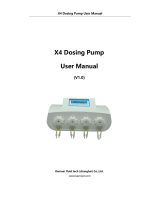
English (GB)
4
1. Safety instructions
These installation and operating instructions contain
general instructions that must be observed during
installation, operation and maintenance of the pump.
It must therefore be read by the installation engineer
and the relevant qualified operator prior to
installation and start-up, and must be available at the
installation location at all times.
1.1 Symbols used in this document
1.2 Qualification and training of personnel
The personnel responsible for the installation,
operation and service must be appropriately
qualified for these tasks. Areas of responsibility,
levels of authority and the supervision of the
personnel must be precisely defined by the operator.
If necessary, the personnel must be trained
appropriately.
Risks of not observing the safety instructions
Non-observance of the safety instructions may have
dangerous consequences for the personnel, the
environment and the pump and may result in the loss
of any claims for damages.
It may lead to the following hazards:
• Personal injury from exposure to electrical,
mechanical and chemical influences.
• Damage to the environment and personal injury
from leakage of harmful substances.
1.3 Safety instructions for the
operator/user
The safety instructions described in these
instructions, existing national regulations on health
protection, environmental protection and for accident
prevention and any internal working, operating and
safety regulations of the operator must be observed.
Information attached to the pump must be observed.
Leakages of dangerous substances must be
disposed of in a way that is not harmful to the
personnel or the environment.
Damage caused by electrical energy must be
prevented, see the regulations of the local electricity
supply company.
Only original accessories and original spare parts
should be used. Using other parts can result in
exemption from liability for any resulting
consequences.
1.4 Safety of the system in the event of a
failure in the dosing pump
The dosing pump was designed according to the
latest technologies and is carefully manufactured
and tested.
If it fails regardless of this, the safety of the overall
system must be ensured. Use the relevant
monitoring and control functions for this.
Warning
If these safety instructions are not
observed, it may result in personal
injury.
If these safety instructions are not
observed, it may result in malfunction
or damage to the equipment.
Notes or instructions that make the job
easier and ensure safe operation.
Before any work to the pump, the pump
must be in the "Stop" operating state
or be disconnected from the power
supply. The system must be
pressureless!
The mains plug is the separator
separating the pump from the mains.
Make sure that any chemicals that are
released from the pump or any
damaged lines do not cause damage to
system parts and buildings.
The installation of leak monitoring
solutions and drip trays is
recommended.





















